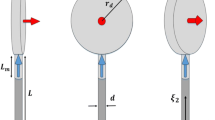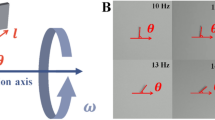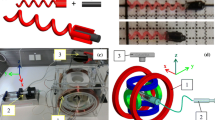Abstract
Magnetic microswimmers are useful for navigating and performing tasks at small scales. To demonstrate effective control over such microswimmers, we implemented feedback control of the three-bead achiral microswimmers in both simulation and experiment. The achiral microswimmers with the ability to swim in bulk fluid are controlled wirelessly using magnetic fields generated from electromagnetic coils. The achirality of the microswimmers introduces unknown handedness resulting in un-certainty in swimming direction. We use a combination of rotating and static magnetic fields generated from an approximate Helmholtz coil system to overcome such uncertainty. There are also movement uncertainties due to environmental factors such as unsteady flow conditions. A kinematic model based feedback controller was created based on data fitting of experimental data. However, the controller was unable to yield satisfactory performance due to uncertainties from environmental factors; i.e., the time to reach target pose under adverse flow condition is too long. Following the implementation of an integral controller to control the microswimmers’ swimming velocity, the microswimmers were able to reach the target in roughly half the time. Through simulation and experiments, we show that the feedback control law can move an achiral microswimmer from any initial conditions to a target pose.
Similar content being viewed by others
References
Ferreira A, Agnus J, Chaillet N, Breguet J-M. A smart mi-crorobot on chip: Design, identification, and control. IEEE/ASME Transactions on Mechatronics, 2004, 9, 508–519.
Zhang H, Hutmacher DW, Chollet F, Poo A N, Burdet E. Microrobotics and MEMS-based fabrication techniques for scaffold-based tissue engineering. Macromolecular Bioscience, 2005, 5, 477–489.
Dogangil G, Ergeneman O, Abbott J J, Pané S, Hall H, Muntwyler S, Nelson B J. Toward targeted retinal drug de-livery with wireless magnetic microrobots. IEEE Interna-tional Conference on Intelligent Robots and Systems (IROS), Nice, France, 2008, 1921–1926.
Fusco S, Chatzipirpiridis G, Sivaraman K M, Ergeneman O, Nelson B J, Pané S. Chitosan electrodeposition for micro-robotic drug delivery. Advanced Healthcare Materials, 2013, 2, 1037–1044.
Kim S, Qiu F, Kim S, Ghanbari A, Moon C, Zhang L, Nelson B J, Choi H. Fabrication and characterization of magnetic microrobots for three-dimensional cell culture and targeted transportation. Advanced Materials, 2013, 25, 5829.
Liu X, Kim K, Zhang Y, Sun Y. Nanonewton force sensing and control in microrobotic cell manipulation. International Journal of Robotics Research, 2009, 28, 1065–1076.
Martel S, Mathieu J-B, Felfoul O, Chanu A, Aboussouan E, Tamaz S, Pouponneau P, Yahia L, Beaudoin G, Soulez G. Automatic navigation of an untethered device in the artery of a living animal using a conventional clinical magnetic resonance imaging system. Applied Physics Letters, 2007, 90, 114105.
Grady M S, Howard M A III, Molloy J A, Ritter R C, Quate E G, Gillies G T. Nonlinear magnetic stereotaxis: Three-dimensional, in vivo remote magnetic manipulation of a small object in canine brain. Medical Physics, 1990, 17, 405–415.
Mathieu J-B, Beaudoin G, Martel S. Method of propulsion of a ferromagnetic core in the cardiovascular system through magnetic gradients generated by an MRI system. IEEE Transactions on Biomedical Engineering, 2006, 53, 292–299.
Abbott J, Peyer K, Lagomarsino M, Zhang L, Dong L, Kaliakatsos I, Nelson B. How should microrobots swim? The International Journal of Robotics Research, 2009, 28, 1434–1447.
Ogrin F Y, Petrov P G, Winlove C P. Ferromagnetic mi-croswimmers. Physical Review Letters, 2008, 100, 218102.
Yesin K B, Exner P, Vollmers K, Nelson B J. Design and control of in-vivo magnetic microrobots. Medical Image Computing and Computer-Assisted Intervention, 2005, 3749, 819–826.
Avron J E, Kenneth O, Oaknin D H. Pushmepullyou: An efficient micro-swimmer. New Journal of Physics, 2005, 7, 234–234.
Najafi A, Golestanian R. Simple swimmer at low Reynolds number: Three linked spheres. Physical Review E, 2004, 69, 062901.
Clearfield A. Current opinion in solid state & materials science. Current Science, 1996, 1, 268.
Singh R, Lillard J W Jr. Nanoparticle-based targeted drug delivery. Experimental and Molecular Pathology, 2009, 86, 215–223.
Tan M L, Choong P F, Dass C R. Recent developments in liposomes, microparticles and nanoparticles for protein and peptide drug delivery. Peptides, 2010, 31, 184–193.
Bae Y H, Park K. Targeted drug delivery to tumors: Myths, reality and possibility. Journal of Controlled Release, 2011, 153, 198–205.
Cheang U K, Kim M J. Self-assembly of robotic micro- and nanoswimmers using magnetic nanoparticles. Journal of Nanoparticle Research, 2015, 17, 145.
Ghosh A, Paria D, Rangarajan G, Ghosh A. Velocity fluc-tuations in helical propulsion: How small can a propeller be. Journal of Physical Chemistry Letters, 2013, 5, 62–68.
Sun C, Lee J S, Zhang M. Magnetic nanoparticles in MR imaging and drug delivery. Advanced Drug Delivery Re-views, 2008, 60, 1252–1265.
Dobson, J. Magnetic nanoparticles for drug delivery. Drug Development Research, 2006, 67, 55–60.
Purcell E M. Life at low Reynolds number. American Journal of Physics, 1977, 45, 3–11.
Zhang L, Abbott J J, Dong L, Kratochvil B E, Bell D, Nelson B J. Artificial bacterial flagella: Fabrication and magnetic control. Applied Physics Letters, 2009, 94, 064107.
Zhang L, Ruh E, Grützmacher D, Dong L, Bell D J, Nelson B J, Schönenberger C. Anomalous coiling of SiGe/Si and SiGe/Si/Cr helical nanobelts. Nano Letters, 2006, 6, 1311–1317.
Tottori S, Zhang L, Qiu F, Krawczyk KK, Franco-Obregón A, Nelson B J. Magnetic helical micromachines: Fabrication, controlled swimming, and cargo transport. Advanced Materials, 2012, 24, 811–816.
Ghosh A, Fischer P. Controlled propulsion of artificial magnetic nanostructured propellers. Nano Letters, 2009, 9, 2243–2245.
Cheang U K, Roy D, Lee J H, Kim M J. Fabrication and magnetic control of bacteria-inspired robotic microswim-mers. Applied Physics Letters, 2010, 97, 213704
Temel F Z, Yesilyurt S. Magnetically actuated micro swimming of bio-inspired robots in mini channels. IEEE International Conference on Mechatronics (ICM), Istanbul, Turkey, 2011, 342–347.
Gao W, Feng X, Pei A, Kane C R, Tam R, Hennessy C, Wang J. Bioinspired helical microswimmers based on vas-cular plants. Nano Letters, 2013, 14, 305–310.
Dreyfus R, Baudry J, Roper M L, Fermigier M, Stone H A. Microscopic artificial swimmers. Nature, 2005, 437, 862–865.
Gao W, Kagan D, Pak O S, Clawson C, Campuzano S, Chuluun-Erdene E, Shipton E, Fullerton E E, Zhang L, Lauga E, Wang J. Cargo — towing fuel — free magnetic nanoswimmers for targeted drug delivery. Small, 2012, 8, 460–467.
Steager E B, Sakar M S, Kumar V, Pappas G J, Kim M J. Electrokinetic and optical control of bacterial microrobots. Journal of Micromechanics and Microengineering, 2011, 21, 035001.
Kim D H, Cheang U K, Kohidai L, Byun D, Kim M J. Artificial magnetotactic motion control of Tetrahymena pyriformis using ferromagnetic nanoparticles: A tool for fabrication of microbiorobots. Applied Physics Letters, 2010, 97, 173702.
Leoni M, Kotar J, Bassetti B, Cicuta P, Lagomarsino M C. A basic swimmer at low Reynolds number. Soft Matter, 2009, 5, 472–476.
Manesh K B, Cardona M, Yuan R, Clark M, Kagan D, Balasubramanian S, Wang J. Template-assisted fabrication of salt-independent catalytic tubular microengines. ACS Nano, 2010, 4, 1799–1804.
Gao W, D’Agostino M, Garcia-Gradilla V, Orozco J, Wang J. Multi-ful driven janus micromotors. Small, 2013, 9, 467–471.
Hong Y, Blackman N M, Kopp N D, Sen A, Velegol D. Chemotaxis of nonbiological colloidal rods. Physical Re-view Letters, 2007, 99, 178103.
Mori N, Kuribayashi K, Takeuchi S. Artificial flagellates: Analysis of advancing motions of biflagellate micro-objects. Applied Physics Letters, 2010, 96, 083701.
Volpe G, Buttinoni I, Vogt D, Kümmerer H-J, Bechinger C. Microswimmers in patterned environments. Soft Matter, 2011, 7, 8810–8815.
Cheang U K, Milutinovic D, Choi J, Kim M J. Towards model-based control of achiral microswimmers. ASME Dynamic Systems and Control Conference, TX, USA, 2014.
Cheang U K, Meshkati F, Kim D, Kim M J, Fu H C. Minimal geometric requirements for micropropulsion via magnetic rotation. Physical Review E, 2014, 90, 033007.
Cheang U K, Kim H, Milutinovic D, Choi J, Rogowski L, Kim M J. Feedback control of three-bead achiral robotic microswimmers. IEEE International Conference on Ubiquitous Robots and Ambient Intelligence (URAI), 2015, 518–523.
Happel J, Brenner H. Low Reynolds Number Hydrodynamics: with Special Applications to Particulate Media, Springer, 1965.
Atherton T J, Kerbyson D J. Size invariant circle detection. Image and Vision Computing, 1999, 17, 795–803.
Sun Y, Duthaler S, Nelson B J. Autofocusing in computer microscopy: Selecting the optimal focus algorithm. Mi-croscopy Research and Technique, 2004, 65, 139–149.
Griffiths D J. Introduction to Electrodynamics, Prentice Hall, Upper Saddle River, NJ, USA, 1999.
Cheang U K, Lee K, Julius A A, Kim M J. Multiple-robot drug delivery strategy through coordinated teams of microswimmers. Applied Physics Letters, 2014, 105, 083705.
Aicardi M, Casalino G, Bicchi A, Balestrino A. Closed loop steering of unicycle like vehicles via Lyapunov techniques. IEEE Robotics & Automation Magazine, 1995, 2, 27–35.
Kim P S S, Becker A, Ou Y, Julius A A, Kim M J. Imparting magnetic dipole heterogeneity to internalized iron oxide nanoparticles for microorganism swarm control. Journal of Nanoparticle Research, 2015, 17, 1–15.
Slotine J J E, Li W. Applied Nonlinear Control, Prentice Hall, Englewood Cliffs, NJ, USA, 1991.
Author information
Authors and Affiliations
Corresponding author
Rights and permissions
About this article
Cite this article
Cheang, U.K., Kim, H., Milutinović, D. et al. Feedback control of an achiral robotic microswimmer. J Bionic Eng 14, 245–259 (2017). https://doi.org/10.1016/S1672-6529(16)60395-5
Published:
Issue Date:
DOI: https://doi.org/10.1016/S1672-6529(16)60395-5




